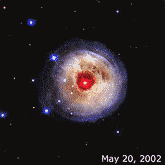Light Fantastic
 On the next hot summer day, imagine what would happen if the Sun suddenly became one million times brighter. Ice cream would quickly melt, sunscreen lotion wouldn't work very well, and that's just the beginning. Thankfully, our Sun doesn't misbehave this way. Yet, in early 2002, we witnessed strange behavior by a star in the dim winter constellation Monoceros (Moh-NO-ser-os) the Unicorn. The star, named V838 Monocerotis (Moh-NO-ser-u-tis) or V 838 Mon for short, grew very bright then cooled and faded away. The glow was bright enough to light up layers of dust surrounding the star, like a flashlight shining through smoke in a dark room.
On the next hot summer day, imagine what would happen if the Sun suddenly became one million times brighter. Ice cream would quickly melt, sunscreen lotion wouldn't work very well, and that's just the beginning. Thankfully, our Sun doesn't misbehave this way. Yet, in early 2002, we witnessed strange behavior by a star in the dim winter constellation Monoceros (Moh-NO-ser-os) the Unicorn. The star, named V838 Monocerotis (Moh-NO-ser-u-tis) or V 838 Mon for short, grew very bright then cooled and faded away. The glow was bright enough to light up layers of dust surrounding the star, like a flashlight shining through smoke in a dark room.
What caused this star to become the brightest star in our Milky Way Galaxy for a short time? Astronomers think V838 Mon suddenly grew hotter and swelled to nearly 1,000 times larger than our Sun. At that size, we could see much more of the star, which explains why V838 Mon appeared so much brighter. Just think...at that size, our Sun would swallow Earth and stretch all the way to Jupiter's orbit!
NASA's Hubble Space Telescope watched the dust shell around V838 Mon over many months after the outburst. Every time Hubble astronomers take a picture, the dust ring looks larger than before. But, in the Hubble pictures, the dust really isn't growing. Instead, light from the flash is sweeping through the dust, lighting up different parts. This illusion is called a 'light echo.'
Fact Credit
NASA Headquarters


